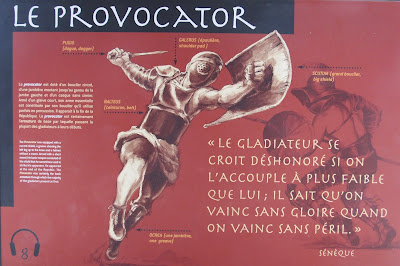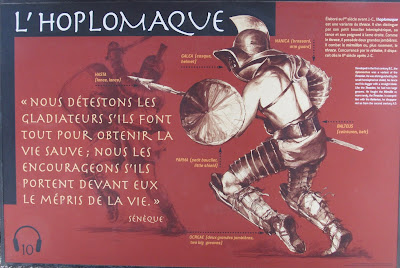
Life in the Arena was all about death and spectacle. It involved opponents exacting blood from their rivals. Although it is difficult today to fathom the attraction of such sport, these games excited the crowds who filled the stadium to watch these competitions. All day long, to the roars of the crowd and the sound of trumpets, the Arena staged one event after another starting with fights between wild animals followed by hunts.

At midday, the most barbaric spectacle involved prisoners being fed to wild beasts.

The highlight of the day were the gladiators' fights, which were cheered on by the crowds.
There were many different types of gladiators who trained to work with specific types of weapons, and the Arena took pains to illustrate this fact with large posters in the Gladiators Gallery shown below.
The Secutor (etymologically, "the one who pursues") was armed with a large shield, the scutum, a short sword, and a small greave. He appeared in the middle of the first century C.E. Developed from the Mirmillo, the Secutor was distinguished by his reinforced helmet, with rough edges and equipped with a finely finished crest in the shape of a half-moon. These characteristics were specifically adapted to resist the trident and the net of his only adversary, the Retiarius. This pair experienced great success from the second century C.E.
The Provocator was equipped with a curved shield, a greave showing the left leg up to the knee and a helmet without a crown. Armed with a short sword, his basi weapon consisted of his shield that he sometimes used to strike his opponent. He appeared at the end of the Republic. The Provocator was certainly the basic armatura through which the majority of the gladiators passed at first.
Developed in the first century B.C.E., the Hoplomachus was a variant of the Thracian. He was distinguished by his small hemispherical shield, his lance and his dagger with a straight blade. Like the Thracian, he had two large greaves. He fought the Mirmillo or, more rarely, the Thracian. In competition with the Retiarius, he disappeared in the second century A.D.
The Retiarius was a gladiator armed with a trident, a dagger, and a net. His left arm was protected by an arm guard supplemented by a shoulder pad, the galerus. Devoid of helmet, greave, and shield, and using arms that did not originate in the military field, the Retiarius was a very distinctive gladiator. He appeared before the end of the first century B.C.E. and fought first with the Mirmillo. It was necessary to wait nearly a century to find him an effective adversary with the Secutor.
Gladiators were volunteers who sacrificed their freedom for glory or monetary gain. They underwent intensive training within the gladiators' school. Though they were treated as slaves, their bravery often won them the admiration of the people. The presence of a referee during solemn fights was systematic. It guaranteed that no cheating, nor alliances between the fighters would occur during contests.
Source:
Amphitheatre of Nimes -- https://www.arenes-nimes.com/en









No comments:
Post a Comment